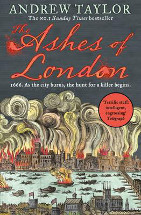The ashes of London by Andrew Taylor

HarperCollins, 2017. ISBN 9780008207755
(Age: secondary to adult) Highly recommended. Themes: Great Fire of
London, Sir Christopher Wren, London, Murder, Restoration,
Commonwealth, Puritans. The year 1666 was already inauspicious
containing three sixes, the mark of Satan to some, making the Great
Fire of London a sign that things had not gone well after the
restoration of Charles 11.
Intrigues still survive with some regicides, those who killed
Charles 1 still at large, and undercurrents of the dissenting ideas
of Cromwell are still at play.
So when a body is found in the ruins of St Paul's, James Marwood,
working for Master Williamson, a real character, editor and
publisher of the London Gazette, is given the job of finding out who
the man is. A second body is found in the Fleet Ditch some days
later and Marwood links the two as they both had their thumbs tied
together behind their backs.
But Marwood's father was a Dissenter, and needs constant attention,
causing Marwood to take time out for his welfare. And when he tells
his son in one of his rambles that he has seen Tom Lovett, Marwood
tries to elicit more information from the old man.
Alongside this story runs another, that of Cat Lovett, Tom's
daughter, taken in by a self serving family after her father
disappeared. People are after him, his politics now out of fashion,
while she is betrothed to a man she does not care for, more
interested in her family property than her. When the son of the
house rapes her she escapes, throwing herself on the mercy of
another family, that of her manservant, Jem, and in their inn she
serves an architect working for Dr Christopher Wren on the plans to
rebuild London. Cat was brought up with a modern thinking aunt who
loved architecture and she developed in her niece some rare
interests and gifts, unusual for those days, so Cat takes a real
interest in the man's work, often helping him as palsy sets in. Told
to leave the inn where she has been working, Cat hides in various
places wanting to keep away from her father and his beliefs.
The political intrigue behind the story is fascinating, revealing
that the Restoration did not smooth over the fraught times of
killing a king or of having Cromwell's Commonwealth ruling Britain.
Monarchists are questioning the extravagance of Charles 11 and his
indebtedness to some of the wealthier men in Britain. Dissenters
cause alarm and those still at large after the execution of Charles
1 are still being hunted down.
The fathers of both Cat and Marwood were involved in the plot
against the king and Marwood is doing his best to help his father,
impeded by his growing dementia and ill health, while Cat's father
is being sought by the authorities for greater reasons that his
beliefs.
Against the converging of these two protagonists is the marvelous
rebuilding of London. Taylor's descriptions of the aftermath of the
fire are riveting, and following the characters as they make their
way through the streets of London makes for exciting reading. Ash
still covers the streets, homeless are everywhere, people wander
about still in shock, food is scarce, surveyors are trying to
establish a sense of boundary markers, and still the London Gazette
publishes its weekly list of the dead, now including the two unknown
men whose identities Marwood is seeking.
This is a most engrossing crime story set within a richly detailed
historical setting.
Fran Knight